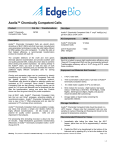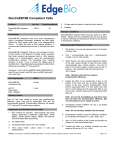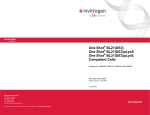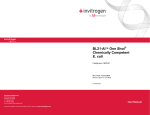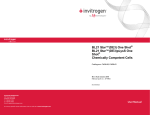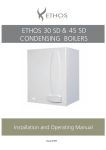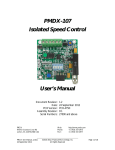Download Ultra BL21 (DE3) Competent Cells
Transcript
Ultra BL21 (DE3) Competent Cells Product Cat. No. Ultra BL21 (DE3) Competent Cells, Tubes Transformations 45363 12 3. A 42°C water bath. 4. 14ml round bottom culture tubes (1 tube per single use aliquot). 5. LB-agar plates or liquid appropriate antibiotic. medium containing the Description Storage Conditions Ultra BL21 (DE3) Competent Cells are chemically competent and have been manufactured using proprietary technology making the cells highly efficient for DNA uptake, thus ultra competent. To utilize the cells at their highest efficiency, a recommended transformation protocol is included with each kit. Ultra BL21 (DE3) Competent Cells should be stored in a -80ºC freezer. Please note that competent cells are very sensitive to cycles of freezing and thawing and should not be exposed to temperature variations. Ultra BL21 (DE3) Competent Cells are available single use tubes that provide a simple and reliable method for highefficiency, single use transformation of host cells. All cells include a test plasmid for quality control purposes. Cells are pre-dispensed in 50µl aliquots (tubes). Full processing time for 1 tube (including recovery) is 1 hour and 20 minutes to ensure the highest level of transformation. Edge BioSystems 8 guarantees transformation efficiencies that exceed 2x10 cfu/µg pUC19. Recommended Protocol for Tubes 1. Immediately after taking the tubes from the -80°C freezer, place them in ice and wait approximately 5 minutes until they thaw. 2. Pipette the DNA to be transformed to the bottom of the tube and mix by pipetting 50µl of air to the bottom of the tube. Control transformation: Dilute pUC19 supercoiled DNA 1:10 with sterile H2O, then add 1µl of the diluted pUC19 supercoiled DNA to one of the tubes. Discard diluted pUC19 supercoiled DNA after use. Genotype: F- ompT hsdSB (rB- mB-) gal dcm (DE3). Kit Components Ultra BL21 (DE3) Competent Cells pUC19 Supercoiled DNA, 100ng/ml 45363 Note: Do not mix by pipetting up and down since that will lower the transformation efficiency. 12 tubes 1 tube Quality Control Each lot is tested to assure high transformation efficiency using 10pg pUC19 supercoiled DNA and the recommended 8 protocol. Transformation efficiency will exceed 2x10 cfu/µg pUC19 under these conditions. Equipment and Materials Not Provided 3. Incubate the tubes in ice for 10 minutes. 4. Transfer the tubes to a 42°C water bath, incubate for 40 seconds and transfer back to ice. 5. Incubate the tubes for 2 minutes in ice. 6. Transfer the cells into a 14ml round bottom culture tube filled with 1ml of pre-warmed SOC medium and then shake at 300 rpm at 37°C for 1 hour. 7. Plate cells on pre-warmed LB-agar selective plates or inoculate into selective liquid medium. For the control transformation with pUC19 supercoiled DNA, plate 10µl on LB-ampicillin agar plates and expect >20 8 colonies (>2 x 10 cfu/µg pUC19). Special Note 1. SOC medium for recovery: 20g/l tryptone, 5g/l yeast extract, 10mM NaCl, 10mM KCl, 10mM MgCl2, 10mM MgSO4, 20mM glucose (MgCl2, MgSO4 and glucose should be added after autoclaving). 2. An orbital shaker. Ultra BL21 (DE3) Competent Cells are based on the T7 expression system. This technology was developed at Brookhaven National Laboratory under contract with the U.S. Department of Energy. Consequently, U.S. patents assigned Warning: This product is intended for research use only. It is not to be used for diagnostic purposes in humans or animals. Page 1 of 2 v. 3 to Brookhaven Science Associates (BSA) protect this technology. These materials are to be used by noncommercial entities for research purposes only. Commercial entities require a license from BSA. You may refuse these cells by returning the enclosed materials unused. To obtain information about licensing, please contact the Office of Intellectual Property and Partnerships, Brookhaven National Laboratory, Building 475D, Upton, NY 11973 (telephone: 631-344-7134 or fax: 631-344-3729). Warning: This product is intended for research use only. It is not to be used for diagnostic purposes in humans or animals. Page 2 of 2 v. 3


